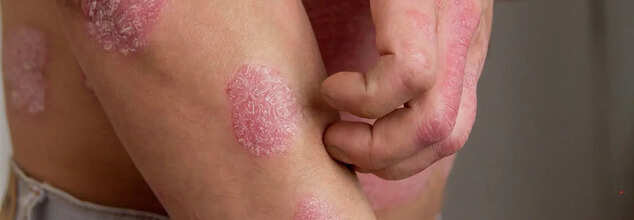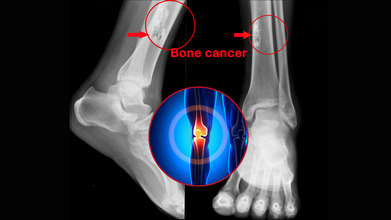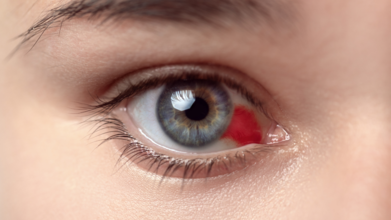- Health Conditions A-Z
- Health & Wellness
- Nutrition
- Fitness
- Health News
- Ayurveda
- Videos
- Medicine A-Z
- Parenting
- Web Stories
UK NHS Warns People With Common Skin Condition To Be Vigilant About 2 Skin Condition

Credit: Canva
Eczema is a common skin condition that causes red or discoloured, itchy patches of skin. It is a type of dermatitis that breaks your skin's barrier functions, which are responsible for helping it retain moisture and protect your body from outside elements. While it can affect people of any age, children are more at risk.
According to the UK NHS, individuals with eczema should monitor any changes in their rashes, especially if accompanied by a high fever or generally feeling unwell, as this could suggest an infection. If they see any signs of infection, they should immediately seek medical advice, as it could escalate into severe conditions such as eczema herpeticum—a potentially dangerous complication caused by the herpes simplex virus that may require hospitalization.
Here are a few signs which you can use to recognise this condition:
- Blistering that oozes, crusts over, or develops pus-filled spots
- Painful, swollen, or warm rashes
- A sudden worsening or spreading of eczema
- High fever or feeling generally unwell
Hidden Risk Of Skin Infections
Eczema weakens the skin’s natural barrier, making it more susceptible to bacterial, fungal, or viral infections. The National Eczema Society notes that most individuals with eczema will encounter some form of skin infection in their lifetime, all of which require medical treatment. Left unchecked, these infections do not improve on their own and can lead to further complications.Atopic eczema, the most common form of the condition, typically presents as itchy, dry, or scaly patches that may differ in color from the surrounding skin. In severe cases, these patches may blister or bleed, further increasing the risk of infection.
Early detection and prompt treatment are essential in preventing complications. If you or your child has eczema, monitoring any changes in the skin—especially signs of infection—can help avoid serious health risks.
What Causes Eczema?
Eczema flares up when your skin comes into contact with substances that irritate it, such as smoke, small bugs in dust, or harsh chemicals. This overburdens your immune system. Some people may be prone to eczema due to genetic factors. It implies that individuals are born with certain genes that influence how well their skin protects them. When the skin's defence is weak, it can't retain moisture and protect against bacteria, allergens, and other environmental factors.
Can Dead Sea Salt Help?
While salts have been known to mitigate Eczema's effect, researchers have said that the Dead Sea in particular is effective in soothing eczema. As the name suggests, Dead Sea salt refers to salt and other mineral deposits collected from the Dead Sea. It is rich in nutrients because sea salt products are minimally processed and are made from evaporated seawater. Dead Sea salt, unlike regular table salt or Epsom salt, is rich with nutrients like magnesium, calcium, sulfur and zinc. The minerals in this water make it effective for skin conditions.
A study in 2005 concluded that soaking in a bath with salt from the Dead Sea can improve your skin's barrier strength, compared with a tap-water soak. This study found that topical treatments with Dead Sea salt improved moisture in the skin. After the sea salt bath, the salt also reduced inflammation.
Bone Cancer Awareness Month: Bone Cancer Isn’t Just an Elderly Disease: When To Suspect A Tumor And Know The Risks At Any Age

Credits: Canva
Bone cancer develops when bone cells start to multiply rapidly and in an unusual manner. This results in break down of the bone. These bone cancer cells may also travel by blood to other oarts of the body like lung and other bones.
Bone tumours occur in two age groups. Children and adolescents and people above the age of 50 years. However it must be remembered that majority of the bony swellings are benign(non-cancerous).
What are the Signs and Symptoms of Bone Cancer?
The bone which is affected may start paining. The pain may be intermittent initially but can later become continuous as the disease progresses. The pain may be worse at night. There may be a swelling or lump in the area. The disease may weaken the bone to cause a fracture. All these symptoms can also be caused by conditions that are not bone cancer. So if you have these symptoms you must tell your doctor.
What Can The Doctor Do?
Your doctor can order an X-ray of the bone affected. If X-ray is suggestive of bone cancer other tests will be required. These include blood tests, imaging studies like CT scan and MRI scan to check the affected bone. A whole body bone scan or PET scan may required to see if the disease has spead to other parts of the body.
A biopsy is required to check if it is actually cancer. The biopsy is sent to a pathologist to confirm the diagnosis. The biopsy should be done by an experienced onco-surgeon. A wrongly placed biopsy site can be disastrous for the patient.
What Are the Treatment Options For Bone Cancer?
Bone cancer if detected in time can be cured. The treatment consists of mainly Sugery and Chemotherapy. Surgery these days involves what is known as limb salvage surgery. This is when the surgeon removes part of the arm or leg where the cancer is growing without removing the whole limb. Chemotherapy is required before and after surgery in many cases. It helps in killing cancer cells which may have spread by blood in the body. With early diagnosis and prompt treatment bone tumour can be cured in a large number of case especially in early stages. There are no common risk factors to bone cancers. Exposure to radiation and a family history are a few known factors.
The key to treatment of bone tumour is early referral to a specialist and management in a specilised oncology centre
My Eye Is Bleeding? What Does It Mean When You Have A Big Red Patch On The Whites Of Your Eye

(Credit-Canva)
A 13-year-old boy walked into the emergency room one day with bloodshot eyes. He didn't have any other eye problems like blurry vision, extra tears, discharge, or pain. He also didn't have a fever or any eye injury. His parents mentioned that for four days before his eyes turned red, he had been vomiting and had diarrhea a lot. This started after they returned home from a trip to Mexico that lasted a few weeks.
When doctors examined him, they found a healthy, awake boy who wasn't in any discomfort. Everything else about his body seemed normal, except for the very red eyes. The redness was in both eyes, underneath the clear outer layer, but there was no discharge, no sensitivity to light, and his eye movements and vision were fine.
Doctors believed his red eyes were caused by the extreme vomiting and gagging he experienced. This pressure likely made tiny blood vessels in his eye burst. He was admitted to the hospital for severe stomach flu. As his vomiting and diarrhea got better, the redness in his eyes also went away by itself within a few days.
A Scary Symptom But ‘Not So Scary’ Cause
According to the American Academy of Ophthalmology (AAO), a subconjunctival hemorrhage is simply one or more bright red spots on the white part of your eye. It happens because the clear covering of your eye, called the conjunctiva, has many tiny blood vessels. When one of these small vessels breaks, blood leaks out and gets trapped between the conjunctiva and the white of your eye (the sclera). This is what creates that noticeable red spot.
Even though these red spots can look alarming, a subconjunctival hemorrhage is usually harmless and will often heal on its own. The main symptom of a subconjunctival hemorrhage is just the red spot itself. You might not even realize you have it until you look in a mirror. Sometimes, you might feel a very slight irritation in your eye, but usually, there's no pain.
What Causes These Red Spots?
Most often, subconjunctival hemorrhages are caused by actions that briefly increase the pressure in your veins, such as:
- Coughing
- Sneezing
- Straining (like when lifting something heavy or having a bowel movement)
- This quick jump in pressure can cause those tiny blood vessels to break.
- Injuries to the eye, even something as simple as rubbing your eyes too hard, can also cause these spots.
Less common causes include:
- Diabetes
- High blood pressure
- Taking medicines that thin your blood, like aspirin or certain blood thinners
- Very rarely, a subconjunctival hemorrhage can be a sign of a blood clotting problem or another blood disorder affecting your whole body.
A subconjunctival hemorrhage typically heals by itself without any specific treatment. The time it takes to clear up depends on the size of the spot, usually ranging from a few days to a few weeks. If your eye feels a bit irritated, you can use artificial tears to help. If you find yourself getting these red spots often, your eye doctor will want to talk with you and might recommend further tests to figure out why.
When These Red Spots Are A Cause Of Concern
AAO explains that it is easy to mix up a hyphema with a common, harmless condition called a subconjunctival hemorrhage, which is just a broken blood vessel in the white part of your eye. A subconjunctival hemorrhage doesn't hurt. However, a hyphema is usually painful and needs proper medical attention right away, or it could cause lasting vision problems.
A hyphema is when blood collects in the front part of your eye. This happens in the space between the clear outer layer which is called the cornea and the colored part of your eye (the iris). The blood can cover some or all of your iris and the dark center of your eye which is the pupil. If you have a hyphema, your vision in that eye might be partly or completely blocked. Hyphema symptoms include,
- Blood in the front of your eye
- Sensitivity to light
- Pain in the eye
- Blurry, cloudy, or blocked vision
What Causes Hyphema?
Since most hyphemas are due to sports injuries, it's very important to wear proper eye protection when playing sports. Injuries from small, fast-moving balls, like in racquetball, can cause serious eye problems beyond just hyphema, such as cataracts, detached retinas, and glaucoma, which can even lead to blindness. However, it is treatable so it is best to visit a doctor to get it checked out
London Psychologist Gave Patients Ketamine, Now Loses License, Here's What We Know So Far

Credits: Wikimedia Commons and CBC news as submitted by Tatiana Zdyb
Tatiana Zdyb admitted to multiple professional misconduct charges, including intimate relationship with patient and misuse of psychedelic therapy
A London-based psychologist who offered ketamine-assisted psychotherapy to clients has been stripped of her license after admitting to serious professional misconduct, including sexual abuse of a patient, misrepresenting her credentials, and offering unproven treatments.
Zdyb, once publicly known for pioneering the use of psychedelic-assisted therapy in Southwestern Ontario, faced a disciplinary hearing on Wednesday before the Ontario College of Psychologists and Behaviour Analysts. The hearing addressed three separate notices of professional misconduct, culminating in the revocation of her license to practice.
The hearing, held in Toronto, heard that Zdyb engaged in an inappropriate and intimate relationship with a long-time patient, provided services unlikely to benefit clients, and misrepresented both her role and the safety of the treatments she was offering.
“These findings are not minor breaches,” said hearing chair Ian Nicholson. “They go to the core of your responsibilities as a regulated professional… Your actions represented a fundamental and egregious betrayal of that trust.”
The Psychedelic Controversy: What Is Ketamine Therapy?
Ketamine, originally developed as a fast-acting anesthetic for medical and veterinary use, has in recent years found a foothold in mental health care, particularly for patients with treatment-resistant depression. It is a controlled substance in Canada, meaning its use outside regulated medical or scientific settings is illegal.
When used under medical supervision, low-dose ketamine infusions or lozenges are believed to rapidly relieve depressive symptoms, sometimes within hours. However, the drug also has hallucinogenic effects and potential for misuse, raising concerns among medical professionals and regulators alike.
While Zdyb was not a medical doctor, she collaborated with prescribing physicians to incorporate ketamine into her psychotherapy sessions. She had previously promoted her clinic, under names like the MindSetting Institute and Zdyb Centre for Health Promotion, as one of the first in the region to offer this form of therapy.
ALSO READ: Matthew Perry Investigation: Can Ketamine Kill Someone?
Ketamine is an anaesthetic used to treat depression, anxiety and pain under supervised and controlled medical settings. However, it does have its side effects, which can lead to distortion of sight, sound and time. It can also produce calming and relaxing effects.
Ketamine increases a person’s heart rate and blood pressure. If overdosed, it can leave users confused and agitated and can cause them to hurt themselves without even realizing it. It can also lead to liver damage and bladder problems.
However, when used in moderation and under the supervision of medical doctors, it can treat depression where traditional antidepressants have failed.
Prof Rupert McShane, a University of Oxford psychiatrist who runs an NHS ketamine treatment clinic told BBC that ketamine “probably turns off the area of the brain that is involved in disappointment.”
In simple terms, it cannot, be if the dosage is given in a controlled setting and as prescribed. Ketamine infusion therapy uses drugs in small doses than those used for anaesthesia. It acts faster than traditional anti-depressants, but the effects also wear off way quickly. Which is why it is important to monitor patients’ mental state for relapsing back into depression and discouraging them from overdosing on it.
YOU MAY WANT TO READ: Can You Use Ketamine To Treat Depression?
Disciplinary Action Follows Settled Lawsuit
The College first issued an interim suspension of Zdyb’s licence in August 2023, pending investigation. But the roots of concern stretch back even further. Lawyer John Nicholson, who represented a former client of Zdyb's under the pseudonym “A.A.”, said his client’s mental health significantly deteriorated after receiving ketamine treatment under Zdyb’s care in 2020 for mild depression.
“She got worse,” Nicholson told CBC News. “And later, Zdyb recommended psilocybin [magic mushrooms] without having the training or expertise to manage that process. My client was unable to return to work and suffered greatly.”
The lawsuit alleged not only inappropriate treatment but also that Zdyb entered into a romantic relationship with A.A. during the course of her therapy, a clear violation of regulatory rules that prohibit any sexual relationship for at least one year after treatment ends. The case was settled out of court, with Nicholson confirming a monetary agreement but declining to share further details.
Admitted Misconduct and License Revocation
At Wednesday’s hearing, Zdyb admitted to all the allegations presented. Her legal representative, Grant Ferguson, acknowledged the “most serious” charge was the sexual relationship with a former client, which began in September 2022, the same month the patient ceased treatment.
But the College’s regulations are unequivocal: any romantic involvement within a year of therapy ending constitutes sexual abuse, carrying severe consequences including mandatory licence revocation.
© 2024 Bennett, Coleman & Company Limited

